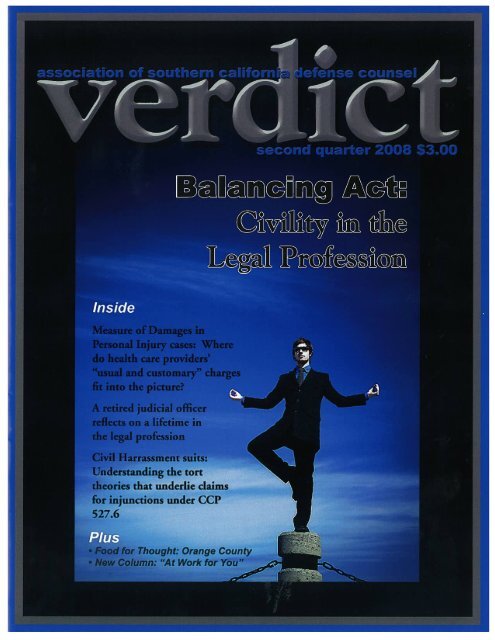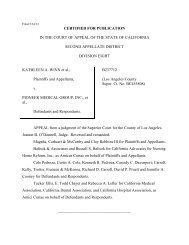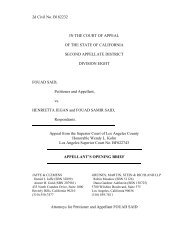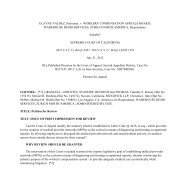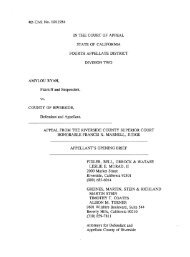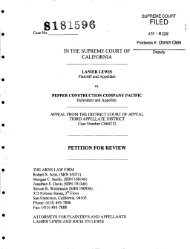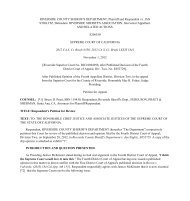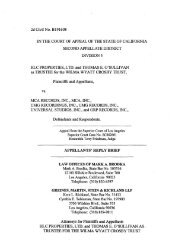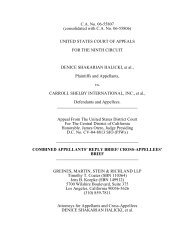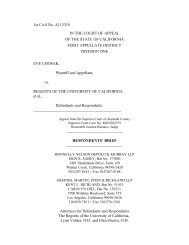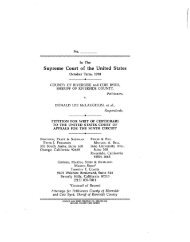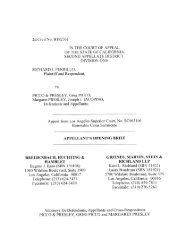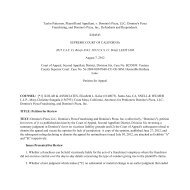Taking the Offense - Greines, Martin, Stein & Richland LLP
Taking the Offense - Greines, Martin, Stein & Richland LLP
Taking the Offense - Greines, Martin, Stein & Richland LLP
You also want an ePaper? Increase the reach of your titles
YUMPU automatically turns print PDFs into web optimized ePapers that Google loves.
. c_)<br />
: 2<br />
o<br />
e 2
<strong>Taking</strong> <strong>the</strong> <strong>Offense</strong><br />
Parrying Claims that “Usual and Customary”<br />
are Indicative of<strong>the</strong><br />
Medical Charges<br />
xtent ofInjury in Personal Injury Actions<br />
By Robert Olson<br />
plaintiff may recover only <strong>the</strong><br />
actual cost of past and future<br />
edical care resulting from<br />
a tortfeasor’s conduct. But to inflate<br />
<strong>the</strong>ir damages some plaintiffs have<br />
attempted to introduce evidence of<br />
retail or so-called “usual and custom<br />
ary” medical care charges above what<br />
has been paid on <strong>the</strong>ir behalf, typically<br />
by <strong>the</strong> plaintiff’s insurer under negoti<br />
ated discounted rates. (See generally<br />
Parnell v. Adventist Health System/West<br />
(2005) 35 Cal.4th 595 [hospital could<br />
not enforce lien against tortfeasor for<br />
“usual and customary” charges exceed<br />
ing discounted rates actually paid by<br />
insurers].) In Greer v. Buzgheia (2006)<br />
141 Cal.App.4rh 1150, <strong>the</strong> Third<br />
District Court of Appeal in Sacramento<br />
held that a plaintiff could introduce evi<br />
dence not only of what <strong>the</strong> plaintiff (or<br />
o<strong>the</strong>rs on <strong>the</strong> plaintiff’s behalf) actu<br />
ally incurred for medical services, but<br />
also <strong>the</strong> higher “usual and customary”<br />
charges. In a world of substantial insur<br />
ance or Medicare discounts such retail<br />
list-price “usual and customary” charges<br />
often greatly exceed what was actually<br />
paid for <strong>the</strong> services as well as <strong>the</strong> aver<br />
age charge for such services.<br />
A plaintiff cannot recover as eco<br />
nomic loss more than what was actually<br />
paid for medical services. That remains<br />
<strong>the</strong> law. But Greer <strong>the</strong>orized that <strong>the</strong><br />
“usual and customary” charge amount<br />
is relevant evidence of <strong>the</strong> extent of <strong>the</strong><br />
plaintiff’s injury for purposes of deter<br />
mining noneconomic general damages.<br />
It fur<strong>the</strong>r held that if <strong>the</strong> defense fails to<br />
obtain a special verdict form separately<br />
enumerating <strong>the</strong> amount of medical<br />
expenses being recovered, <strong>the</strong> defense<br />
cannot complain that <strong>the</strong> jury may have<br />
mistakenly awarded <strong>the</strong> excessive “usual<br />
and customary” medical charges as part<br />
of economic loss.<br />
Plaintiffs have taken Greer as a carte<br />
blanche to introduce <strong>the</strong> “usual and<br />
customary” medical charges in virtu<br />
ally any kind of personal injury case.<br />
Greer may well be wrongly decided and<br />
subject to fur<strong>the</strong>r appellate scrutiny,<br />
especially outside of <strong>the</strong> Third Appellate<br />
District in California. The purpose<br />
of this article, however, is to provide<br />
an approach to handling plaintiffs’<br />
attempts to introduce evidence of “usual<br />
and customary” charges within <strong>the</strong><br />
framework of Greer as it currently exists<br />
as precedent. In particular, this article<br />
advocates that defense counsel take<br />
<strong>the</strong> offensive to exclude such “Greer<br />
evidence” or to so blunt or reverse its<br />
impact as to make it not worth plain<br />
tiffs’ while.<br />
Greer’s Rationale<br />
An injured party is certainly entitled to<br />
recompense from a legally responsible<br />
defendant for that party’s economic<br />
loss. But it should be a truism that an<br />
injured party is not entitled to recover<br />
more than that parry in fact has to pay<br />
to o<strong>the</strong>rs. (Hanifv. Housing Authority<br />
(1988) 200 Cal.App.3d 635, 639-644;<br />
Nishihama v. City and County ofSan<br />
Francisco (2001) 93 Cal.App.4th 298,<br />
308.) Where <strong>the</strong> collateral source rule<br />
applies, <strong>the</strong> defendant may not reduce<br />
its liability by claiming <strong>the</strong> plain<br />
tiff’s damages were paid by or will be<br />
recouped from o<strong>the</strong>rs (such as healthcare<br />
insurers), but even under that rule,<br />
2nd quarter 2008 verdict 17
actual<br />
—<br />
—<br />
<strong>Taking</strong> <strong>the</strong> <strong>Offense</strong> (continued)<br />
<strong>the</strong><br />
defendant’s liability for<br />
loss is to <strong>the</strong><br />
ally by someone (i.e., <strong>the</strong><br />
tied<br />
incurred<br />
economic<br />
amount of harm actu<br />
plain<br />
tiff or <strong>the</strong> plaintiff’s collateral source).<br />
Greer does<br />
to<br />
from this<br />
“Usual customary” charges are not a<br />
recoverable measure economic<br />
ages are <strong>the</strong> charges actually<br />
by (or on<br />
(See Greer, supra, 141<br />
at p. 1157.) Ra<strong>the</strong>r, Greer holds<br />
trial has “broad<br />
ity” to evidence <strong>the</strong> often<br />
“usual customary” value<br />
medical care as relevant to <strong>the</strong> extent<br />
<strong>the</strong> plaintiff’s noneconomic injuries<br />
(e.g., suffering), relying on<br />
Nishihama, supra, for<br />
(Id. at pp.<br />
paid<br />
<strong>the</strong><br />
inflated<br />
of<br />
and<br />
if those<br />
not purport<br />
depart<br />
fundamental proposition.<br />
court<br />
admit<br />
pain and<br />
not<br />
of<br />
dam<br />
behalf of) <strong>the</strong> plaintiff.<br />
and<br />
1156-1157.)<br />
Cal.App.4th<br />
of<br />
author<br />
that<br />
that proposition.<br />
In fact, Greer is a radical expansion<br />
of Nishihama. Nishihama addressed<br />
only<br />
limited<br />
of<br />
a issue — whe<strong>the</strong>r <strong>the</strong><br />
sibly admission <strong>the</strong><br />
mal” cost<br />
care required<br />
reversal thc noneconomic award where<br />
any prejudicial effect on <strong>the</strong> economic<br />
award (or lack in<br />
lar case be precisely identified.<br />
(Nishihama, supra, 93<br />
at<br />
pp.<br />
Nishihama could deduce<br />
no prejudice<br />
require<br />
damages.<br />
said is “[ti here is<br />
no reason to assume <strong>the</strong> usual rates<br />
a less accurate<br />
<strong>the</strong> extent<br />
injuries <strong>the</strong> specially<br />
ated rates by Blue Cross.” (Id.<br />
at p. 309.) Nishihama’s<br />
<strong>the</strong> equivalent<br />
ing such evidence was properly<br />
ted for purpose, Greer read it<br />
as<br />
“usual<br />
customary” charges as a yardstick for<br />
evaluating suffering damages.<br />
(Greer, supra, 141<br />
at pp.<br />
improper<br />
of th nedical<br />
of<br />
could<br />
305-307.)<br />
<strong>the</strong>reof)<br />
that would<br />
culating <strong>the</strong> noneconomic<br />
What Nishihama<br />
provided<br />
finding was<br />
of<br />
pos<br />
“nor<br />
that particu<br />
Cal.App.4th<br />
that<br />
that<br />
recal<br />
indicator of<br />
of plaintiff’s [noneconomic]<br />
than did<br />
that<br />
obtained<br />
not<br />
but<br />
approving introduction of<br />
1156-1157.)<br />
negoti<br />
no-prejudice<br />
pain and<br />
Cal.App.4th<br />
of hold<br />
admit<br />
and<br />
Greer recognized <strong>the</strong><br />
table<br />
between<br />
<strong>the</strong><br />
actual medical charges<br />
(recoverable<br />
loss to <strong>the</strong> extent<br />
reasonable caused by<br />
duct) “usual customary”<br />
es, in fact (and <strong>the</strong>refore<br />
recoverable). Its was to foist<br />
defense counsel <strong>the</strong><br />
ity to a special verdict form<br />
separately shows <strong>the</strong><br />
expenses awarded as<br />
loss so<br />
<strong>the</strong> trial<br />
or an<br />
appellate can<br />
exceeds what <strong>the</strong> evidence<br />
for<br />
at pp.<br />
upon<br />
that<br />
amount<br />
ports<br />
potential confusion<br />
amount of<br />
economic<br />
and<br />
and<br />
obtain<br />
not paid<br />
and<br />
solution<br />
inevi<br />
tortious con<br />
charg<br />
not<br />
responsibil<br />
that<br />
amount of medical<br />
economic<br />
court post-verdict<br />
court<br />
determine if that<br />
sup<br />
actual medical expenses. (Id.<br />
1157-1159.)<br />
Approaches to Dealing<br />
with Greer<br />
Plaintiffs have taken Greer as freely<br />
approving <strong>the</strong> admission evidence<br />
“usual customary” charges.<br />
be case. are a<br />
steps defense counsel<br />
can take to exert over <strong>the</strong> issue<br />
in a fashion may restore<br />
balance.<br />
and<br />
should not<br />
number of<br />
<strong>the</strong><br />
that<br />
that<br />
control<br />
of<br />
There<br />
ultimately<br />
Assert an Evidence Code<br />
section 352 objection<br />
That<br />
Greer recognizes trial court’s have<br />
“broad<br />
to or<br />
gentially relevant evidence. (141 Cal.<br />
Ap’p.4th at p. 1156.) Evidence<br />
section 352, course, allows <strong>the</strong> trial<br />
to exclude evidence it views<br />
as more time<br />
misleading,<br />
confusing or o<strong>the</strong>rwise prejudicial<br />
probative. in Greer limits <strong>the</strong><br />
ability a trial to exclude “usual<br />
customary” charges evidence on<br />
basis.<br />
prejudice<br />
by such evidence includes <strong>the</strong><br />
possibility confusion as<br />
to what <strong>the</strong><br />
cal expense damages is — charges<br />
or “usual customary” charges. In<br />
as discussed below, <strong>the</strong><br />
such “usual customary”<br />
court<br />
and<br />
that<br />
sented<br />
strong<br />
authority”<br />
of<br />
addition,<br />
duction of<br />
of<br />
that<br />
admit<br />
consuming,<br />
Nothing<br />
court<br />
The potential<br />
and<br />
of jury<br />
proper measure<br />
and<br />
that<br />
not tan<br />
Code<br />
of medi<br />
of<br />
than<br />
pre<br />
intro<br />
charge evidence opens up a for<br />
collateral issues (e.g., <strong>the</strong> true usual cost<br />
of medical care,<br />
correlate with <strong>the</strong> severity<br />
take up an<br />
potential<br />
whe<strong>the</strong>r medical costs<br />
of<br />
inordinate amount of<br />
The counterbalancing<br />
injury) to<br />
time.<br />
probative<br />
value “usual customary” medi<br />
cal expenses for <strong>the</strong> sole reason <strong>the</strong>y<br />
are proffered — extent <strong>the</strong> plaintiff’s<br />
— is exceedingly low. There is<br />
no correlation between <strong>the</strong><br />
supposedly “customary” price<br />
cal bills <strong>the</strong> extent injury. More<br />
expensive medical does<br />
necessarily correlate with greater<br />
vice versa. For example, <strong>the</strong> medi<br />
cal bills to<br />
a limb or to<br />
a deceased may be much<br />
less those to successfully treat a less<br />
bacterial infection with<br />
sive drugs or to<br />
a relatively<br />
over <strong>the</strong> course several<br />
days in <strong>the</strong> hospital.<br />
injury<br />
and<br />
of<br />
consistent<br />
nounce<br />
than<br />
injurious<br />
and<br />
and<br />
amputate<br />
victim<br />
minor ailment<br />
Having<br />
of<br />
of<br />
treatment<br />
monitor<br />
of medi<br />
of<br />
not<br />
injury<br />
pro<br />
expen<br />
an expert prepare rough<br />
estimates <strong>the</strong> “customary” costs<br />
procedures associated with varying<br />
injuries may be helpful in presenting to<br />
a <strong>the</strong> lack correlation between<br />
expense injury. customary<br />
costs care simply does provide<br />
help to a<br />
is trying to<br />
evaluate <strong>the</strong> severity<br />
for<br />
injuries.<br />
court<br />
much<br />
of<br />
of<br />
and<br />
of<br />
The<br />
jury that<br />
not<br />
corresponding compensation<br />
economic<br />
of<br />
of harm and <strong>the</strong><br />
non<br />
Equally, <strong>the</strong> cost<br />
well vary between different locales.<br />
fact it costs more to treat a<br />
lar in, say, Los Angeles, for<br />
example, Bakersfield, does<br />
<strong>the</strong> in Los Angeles has<br />
fered greater<br />
<strong>the</strong> in Bakersfield. Again, such<br />
an example can illustrate to a trial<br />
<strong>the</strong> lack<br />
is, <strong>the</strong><br />
lack<br />
logical<br />
between medical bills and general<br />
ages.<br />
that<br />
that<br />
injury<br />
plaintiff<br />
plaintiff<br />
of treatment may<br />
The<br />
particu<br />
than,<br />
not mean<br />
suf<br />
non-economic injury than<br />
of correlation<br />
of probative<br />
that<br />
connection<br />
court<br />
dam<br />
Trial courts have broad discretion<br />
to exclude evidence section 352.<br />
under<br />
1 8 verdict 2nd quarter 2008
arely,<br />
i.e.,<br />
A trial court convinced of <strong>the</strong> tenu<br />
ousness of any logical inference to be<br />
drawn between “usual and customary”<br />
charges and <strong>the</strong> extent of physical inju<br />
ries would be well justified in excluding<br />
evidence of such charges on Evidence<br />
Code section 352 grounds. Given <strong>the</strong><br />
trial court’s broad discretion, such a<br />
ruling would be exceedingly difficult to<br />
challenge on appeal.<br />
Proffer countervailing<br />
evidence<br />
Plaintiffs often simply proffer <strong>the</strong> “usual<br />
and customary” medical charges based<br />
on a column from a health care pro<br />
vider’s rate sheet and hold out that stan<br />
dard as if it is set in stone. Of course, it<br />
is not. In most cases, amounts reflected<br />
on such lists are an illusion — if<br />
ever, collected. The defense should be<br />
prepared to proffer evidence of that<br />
fact. The plaintiff is proffering “usual<br />
and customary” charges on <strong>the</strong> <strong>the</strong>ory<br />
that such charges more closely reflect<br />
<strong>the</strong> real value of medical services (and<br />
supposedly, <strong>the</strong>refore, <strong>the</strong> real extent of<br />
<strong>the</strong> plaintiff’s injury) than <strong>the</strong> actual<br />
amounts paid. The defense should be<br />
entitled to present evidence that <strong>the</strong> real<br />
“usual and customary” charges are those<br />
that medical providers typically collect<br />
for <strong>the</strong>ir services. A useful analogy may<br />
be found in o<strong>the</strong>r consumer contexts: a<br />
computer, software, or even a car may<br />
have a “list” or ‘MSRP” price that is far<br />
above its “street price.” If <strong>the</strong> plaintiff<br />
seeks to present “list price” evidence,<br />
<strong>the</strong> defense should be entitled to pres<br />
ent evidence of <strong>the</strong> “street price.”<br />
The plaintiff, or <strong>the</strong> trial court,<br />
may complain that such evidence is<br />
going to be time-consuming or tan<br />
gential. But it is <strong>the</strong> natural partner to<br />
plaintiff’s evidence regarding “usual and<br />
customary” charges. Having opened <strong>the</strong><br />
door on <strong>the</strong> subject, <strong>the</strong> plaintiff should<br />
not be <strong>the</strong> only party allowed to present<br />
evidence as to <strong>the</strong> reasonable value of<br />
medical services as a standard by which<br />
to judge <strong>the</strong> extent of physical injury.<br />
That <strong>the</strong> inquiry is time-consuming<br />
and tangential simply highlights why<br />
Evidence Code section 352 should pre<br />
clude inquiry into <strong>the</strong> whole area.<br />
Ask for a special instruction<br />
Given <strong>the</strong> significant potential for<br />
jury confusion between charges actu<br />
ally paid and “usual and customary”<br />
charges, defense counsel should request<br />
an instruction directing <strong>the</strong> jury that it<br />
cannot award as economic damages any<br />
amount exceeding <strong>the</strong> amounts actually<br />
and reasonably paid, and that addition<br />
al “usual and customary” charges cannot<br />
be awarded as noneconomic damages<br />
but can only be used (if at all) to help<br />
gauge <strong>the</strong> extent of injury in determin<br />
ing noneconomic damages. (Note that<br />
CACI No. 3903A references only <strong>the</strong><br />
“reasonable cost of reasonably necessary<br />
medical care” standard, a standard that<br />
a jury could easily confuse with “usual<br />
and customary” charges. The use notes<br />
cite to Hanif’s limitation to amounts<br />
actually expended. Defense counsel<br />
should not propose or acquiesce in giv<br />
ing CACI 3093A without asking for<br />
a complementary instruction on that<br />
limitation. It may be effective to ask<br />
plaintiff’s counsel to stipulate to such<br />
an instruction and, if counsel refuses,<br />
to suggest to <strong>the</strong> court that counsel<br />
has two choices: to stipulate or not to<br />
present “usual and customary” medical<br />
expense evidence.<br />
In addition, defense counsel may<br />
wish to request a limiting instruction<br />
when any “usual and customary” medi<br />
cal charges evidence is first introduced<br />
to <strong>the</strong> effect that it can be used, if at all,<br />
only for a limited purpose — as pos<br />
sibly reflecting <strong>the</strong> extent of injury for<br />
general damages purposes, but that <strong>the</strong>y<br />
are not a measure of general damages<br />
and are not recoverable as a component<br />
of general damages in <strong>the</strong>ir own right.<br />
(E.g., Evid. Code, § 355; CACI No.<br />
206.)<br />
Request a special verdict form<br />
segregating <strong>the</strong> amount of<br />
medical expenses awarded as<br />
economic damages<br />
Greer directs that <strong>the</strong> defense has to<br />
request a separate verdict form detailing<br />
<strong>the</strong> amount of medical expenses award<br />
ed as economic damage to preserve any<br />
challenge that <strong>the</strong> verdict improperly<br />
includes damages inflated beyond <strong>the</strong><br />
true amount needed for compensation.<br />
(Greer, supra, 141 Cal.App.4th at pp.<br />
1157-1159.) If this is defense counsel’s<br />
duty under Greer, it is also <strong>the</strong> defense’s<br />
right. Counsel should insist on such a<br />
special verdict form.<br />
One problem, however, is that par<br />
ties often dispute <strong>the</strong> amount or type<br />
of treatment reasonably required by <strong>the</strong><br />
injury. There is no way to tell whe<strong>the</strong>r<br />
a special verdict that awards an amount<br />
greater than <strong>the</strong> defendant’s estimate<br />
reflects an agreement with plaintiff<br />
regarding <strong>the</strong> scope of needed treatment<br />
and is based on <strong>the</strong> actual, reasonable<br />
costs of that treatment (consistent with<br />
proper compensatory principles), or<br />
reflects an agreement with defendant as<br />
to <strong>the</strong> scope of treatment but is based<br />
on inflated “customary” charges for<br />
such treatment (contrary to basic com<br />
pensation principles). In an appropriate<br />
case, counsel can also request a break<br />
down between various medical services<br />
so that it can be ascertained whe<strong>the</strong>r<br />
<strong>the</strong> jury awarded an excessive amount<br />
of medical expenses as to any services<br />
where additional “usual and customary”<br />
evidence was presented.<br />
If plaintiff’s counsel balks at such<br />
a verdict form, <strong>the</strong> defense can argue<br />
that plaintiff had <strong>the</strong> choice of not pre<br />
senting “usual and customary” charge<br />
evidence. But, if plaintiff does so, <strong>the</strong><br />
separate jury interrogatories are a matter<br />
of right.<br />
2nd quarter 2008 verdict 19
in California until disagreed with by<br />
by <strong>the</strong> Third District or <strong>the</strong> Supreme<br />
ano<strong>the</strong>r Court of Appeal or disapproved<br />
damages. Fur<strong>the</strong>r, counsel may wish to<br />
Greer is binding on all trial courts<br />
As <strong>the</strong> holding of a Court of Appeal,<br />
may wish to make clear that actual<br />
decides that introduction of “usual<br />
that <strong>the</strong> jury may award as economic<br />
The result may be that <strong>the</strong> plaintiff<br />
medical expenses are <strong>the</strong> maximum<br />
issue can be taken from <strong>the</strong> plaintiff.<br />
on <strong>the</strong> Greer medical expense damages<br />
Reserve objection to<br />
Greer’s holding<br />
in arguing to <strong>the</strong> jury, defense counsel<br />
20 verdict 2nd quarter 2008<br />
— for<br />
fies preservation of <strong>the</strong> issue on appeal<br />
<strong>the</strong> defense disagrees with Greer and<br />
For that reason, in <strong>the</strong> trial court careful<br />
defense counsel will want to note that<br />
<strong>the</strong> defense to provide notice that<br />
it intends to challenge existing law on<br />
appeal.<br />
ed. 1997) Appeal, § 934, pp. 971-973.)<br />
(E.g., 9 Witkin, Cal. Procedure (4th<br />
It is entirely appropriate —<br />
and<br />
on o<strong>the</strong>r appellate courts in California.<br />
intends to pursue <strong>the</strong> issue on appeal.<br />
Court. Greer, however, is not binding<br />
solidi<br />
<strong>Taking</strong> <strong>the</strong> <strong>Offense</strong> (continued)<br />
plaintiff to be overreaching given that<br />
independent measure of recovery.<br />
plaintiff is overreaching in one regard<br />
may be<br />
— e.g.,<br />
medical bills —<br />
plaintiff<br />
demonstrably inflated “usual and cus<br />
argue that plaintiff’s introduction of<br />
tomary” charges shows an attempt by<br />
healthcare expense and are not a proper<br />
those charges are not reflective of real<br />
Defense counsel can also suggest that if<br />
overreaching in o<strong>the</strong>rs.<br />
Argue <strong>the</strong> issue<br />
Annual Seminar.<br />
in Review “program at <strong>the</strong> Association’s<br />
and a long-time presenter of<strong>the</strong> “Year<br />
tions for extraordinary writs, and o<strong>the</strong>r<br />
Defense Counselc amicus committee<br />
<strong>the</strong> Association ofSou<strong>the</strong>rn California<br />
and hisfirm specialize in appeals, peti<br />
<strong>Martin</strong>, <strong>Stein</strong> & Richiand LU? He<br />
Robert Olson is a partner in <strong>Greines</strong>,<br />
appellate proceedings. He is co-chair of<br />
worth <strong>the</strong> effort. If not, <strong>the</strong>se steps may<br />
and customary” charges may not be<br />
enhance <strong>the</strong> record for any appeal on<br />
<strong>the</strong> Greer issue. •<br />
With some of <strong>the</strong>se steps <strong>the</strong> initiative<br />
Conclusion


